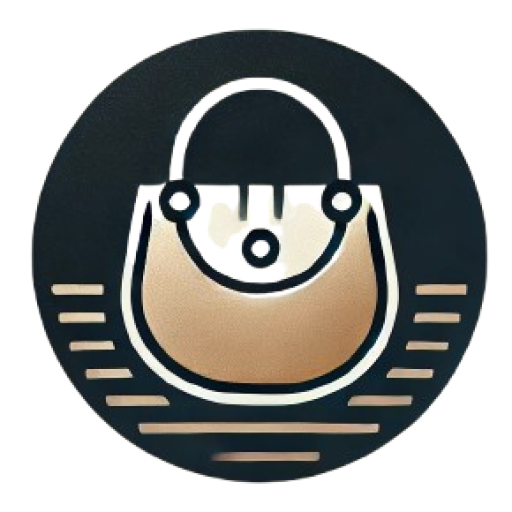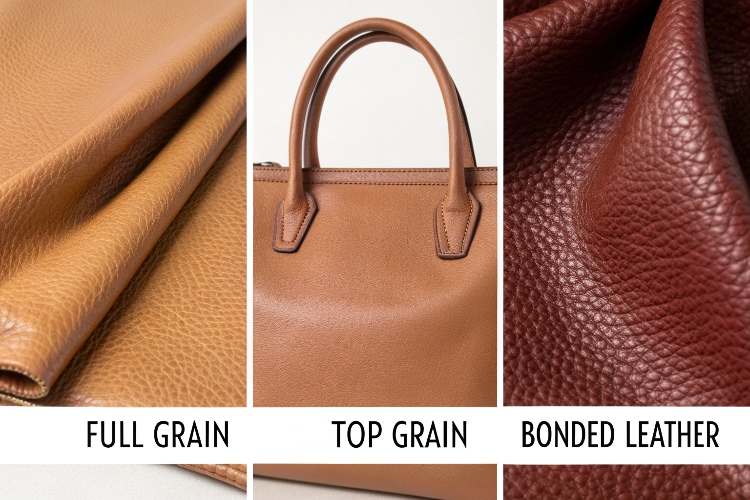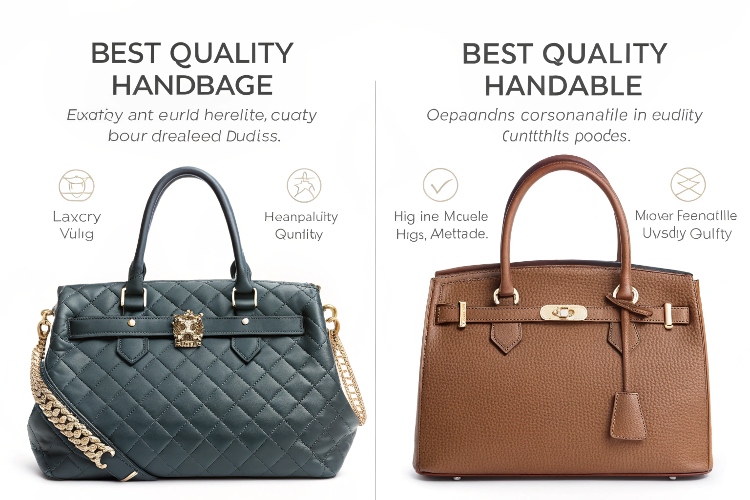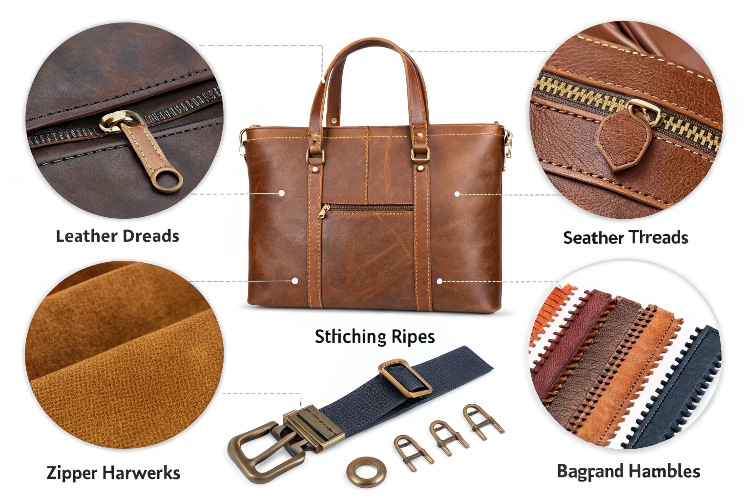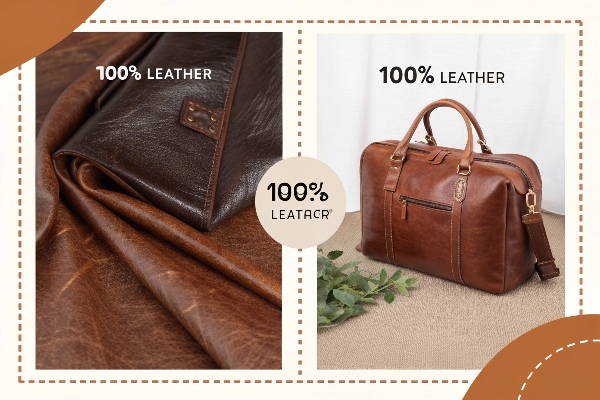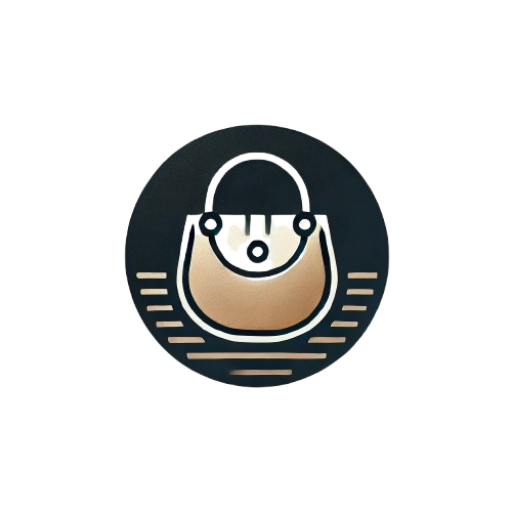- Leather Grade – Look for “full-grain” or “top-grain” labels (avoid “bonded” or “genuine leather”).
- Stitching – 6-8 stitches per inch (tight, even, and double-stitched stress points).
- Edge Details – Smooth, painted, or burnished edges (no fraying or exposed fibers).
- Thickness – Premium leather is 1.2–1.6mm thick; too thin (<1mm) cracks easily.
- Hardware – Solid brass/copper zippers (not lightweight plastic or painted metal).
- Flexibility – Quality leather softens slightly with use but retains shape (stiffness fades in 2-3 weeks).
Design Details Inspection (Stitch Density, Hardware Materials)
Stitch Density: The Quality Code Hidden in Needlework
If you’ve seen Hermès artisans sewing bags, you’ll notice they use rulers to measure stitch spacing—this isn’t OCD, but adherence to the industry’s golden standard of 6-8 stitches per inch. Gently scratch the seams with your fingernail: quality stitching aligns like piano keys, while cheap bags have threads resembling drunken centipede legs (uneven gaps). Fun fact: Italian workshops use horsehair thread that expands when wet to fill needle holes automatically, surviving rainstorms without unraveling.
Hardware Materials: The Quality Detector More Accurate Than a Bathroom Scale
When touching metal clasps, first test the weight—zinc alloy feels light like soda can tabs, while solid brass has the heft of car keys. Quickly tap the hardware with your nail: quality metal rings with a sustained “ding—”, while cheap versions make a fart-like thud. Insider tip: YKK zippers hide anti-counterfeiting marks on the back of teeth, visible only with angled flashlight light—more thrilling than checking banknotes.
At a Brooklyn vintage leather shop, the owner taught me a ruthless trick: rub metal hardware against jeans 10 times quickly. Real brass leaves faint blue streaks (oxidized layer wearing off), while plated hardware reveals white base metal. This made a girl buying fake luxury bags burst into tears next door, but it’s more convincing than any lab report.
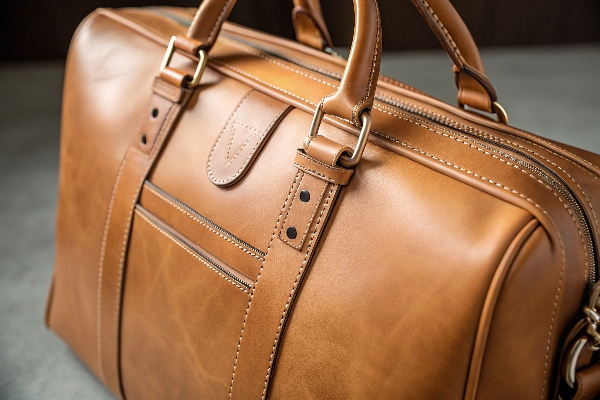
Functional Evaluation (Pocket Layout, Shoulder Strap Load-Bearing)
Pocket Layout: Keep Phones and Keys Separate
The worst bags have “black hole pockets” – you dump everything inside and spend ages fishing for earphones. Truly functional designs mimic the tote bags from New York brand Baggu: zippered compartments in the main cavity hold passports, elastic mesh side pockets keep water bottles upright, and a magnetic snap front pocket allows quick access. British leather brand Cambridge Satchel Company adds a tiny hook inside the flap to hang keys, preventing them from scratching phone screens.
Shoulder Strap Load-Bearing: Avoid the “Guillotine” Trap
A 2023 US Consumer Association test revealed over 60% of bag damages occur at shoulder strap connections. Check three critical points: 1. Stitch density must reach at least 6 stitches per inch (drag your nail across seams – if it feels like a washboard, it’s solid); 2. Hardware must be solid brass (use a magnet – attracted pieces are alloy-plated and will discolor within months); 3. Italian brand Piquadro’s patented design adds a vegetable-tanned leather strip on strap backs, acting as shoulder shock absorbers.
Real-World Testing Tips
During store trials, fill the bag with magazines to simulate daily load. Wear it single-shoulder for 10 minutes. If you experience strap slippage, collarbone pressure, or the bag tilts forward (common in Swiss brand Freitag’s recycled material models), the weight distribution is flawed. Pro buyers check bottom reinforcement – Japanese brand PORTER’s classic models add 1.2mm thick cowhide layers at the base, boosting durability by 30%.
Brand Reputation & After-Sales Service (Warranty Policies & Repair Services)
Don’t be a sucker – check the warranty card first
Ask before buying: How many years is the warranty? International coverage? For example, Coach offers free repairs in the US (non-artificial damage within 5 years), but European repairs might require local agents. Italian artisan workshops may only provide domestic warranties – many tourists get trapped by these hidden clauses.
Repairs aren’t always guaranteed
Real case from last year: A New Yorker bought a Mansur Gavriel bucket bag with broken strap hardware. The brand only repairs items bought from their official website, while department store purchases must go through the retailer. Remember three things: 1. Keep purchase proof 2. Confirm repair scope 3. Ask about fees (some brands charge for cleaning).
Expose brand skeletons
Check real complaints on Trustpilot instead of believing official hype. Pro tip: Search “brand name + leather bag complaints” to find truths – AllSaints gets criticized for excluding tarnished hardware from warranties, while Polène‘s Paris workshop has painfully slow repairs. Reddit’s r/handbags subreddit contains veterans’ horror stories.
Beware these warranty traps
• Italian brands’ wordplay: “lifetime warranty” actually means “during the brand’s operational period”
• Online purchases: Farfetch third-party sellers might not handle after-sales
• Engraving/customization voids warranties (Louis Vuitton does this)
Insider tricks
When buying Goyard in Paris, always ask for a paper warranty card (they often “forget”). For Japanese vintage store Hermès, authenticate at boutique before maintenance. Cold fact: Loewe‘s edge paint cracks get better repairs at Spain HQ than Asian branches – ship directly to the factory.
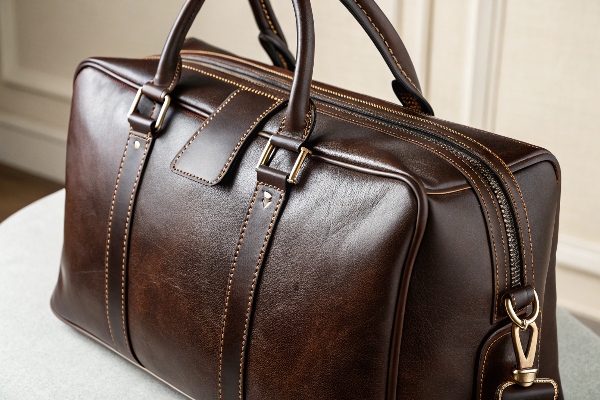
Cost-Performance Balance (Avoid Overpaying for Brand Premiums)
Brand Premium ≠ Quality Assurance
Don’t be dazzled by big brand logos. New York leather craftsman Jake once revealed in an interview: “Some luxury bags use leather that costs less than 10% of the retail price, with hardware that’s worse than fast fashion brands.” For example, a classic tote from an Italian brand sells for $2500+ on their official website but uses machine-embossed “corrected grain” split leather. Meanwhile, Polish niche brand Samecki offers similar styles handmade from top-grain calfskin for just $600.
Learn to Identify Real Materials
Remember these three hard indicators: leather type (Full Grain > Top Grain > Split), stitch density (6+ stitches per inch), and hardware weight (solid brass lasts 2-3 times longer than zinc alloy). Reddit leather enthusiasts conducted scratch tests showing a $300 Beckett Simonon bag outperformed a $1800 contemporary luxury brand in durability.
Smart Strategies for Affordable Alternatives
Focus on Eastern European and Mexican independent workshops. Lithuanian brand Nümph uses German Perlinger eco-leather at 1/3 the price of similar luxury brands. Mexican family business Casa de Cuero, after 20 years of manufacturing for Ralph Lauren, now sells directly with 40% lower prices. The Wall Street Journal’s 2023 review found these “factory brands” provide more transparent leather quality data.
Discount Seasons Are Key
Savvy shoppers strike during post-Easter and pre-Black Friday sales. A Nordstrom sales associate revealed that while classic luxury styles rarely discount, brands like Tory Burch and Coach often offer 40% off on past-season genuine leather items. Pro tip: Email brands directly to ask about “sample sales” – Brooklyn boutique Screaming Mimis’ sample section once hid an $800 vintage Céline bag with thicker leather than current models.
Don’t Blindly Trust Certifications
“Italian imported leather” might mean Chinese raw hides processed in Italy. Check LWG certification (Leather Working Group) instead – only 35% of global tanneries meet this environmental standard. Insider fact: Hermès’ Calvi leather cardholder costs less than 8% of its retail price to produce, while Portuguese brand O My Bag sells similar leather items for $95 with QR codes tracing material origins.
